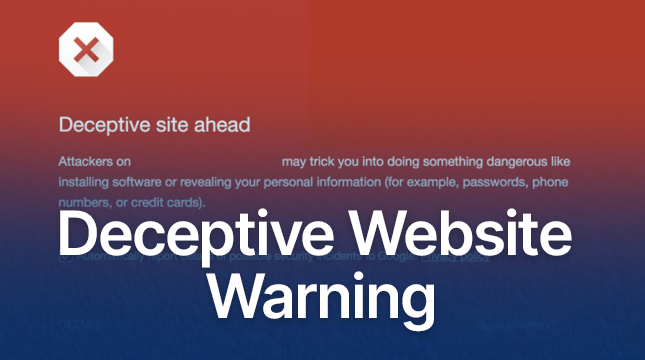This website uses cookies so that we can provide you with the best user experience possible. Cookie information is stored in your browser and performs functions such as recognising you when you return to our website and helping our team to understand which sections of the website you find most interesting and useful.
Deceptive Website Warning

Deceptive Website Warning: How to Stay Safe Online
In the vast expanse of the internet, deceptive websites lurk like digital predators, waiting to pounce on unsuspecting users. Recognizing and avoiding these malicious sites is crucial for maintaining your online safety. In this comprehensive guide, we’ll explore everything you need to know about deceptive websites, including how to identify them, protect yourself, and educate others.
Read More : Wix vs WordPress: Which is the Best Website Builder for You?
Understanding Deceptive Websites
What are Deceptive Websites?
Deceptive websites are malicious sites designed to trick users into divulging personal information, downloading malware, or making fraudulent transactions. They often mimic legitimate websites to appear trustworthy and lure users into their traps.
Common Characteristics of Deceptive Websites
- Suspicious URLs: Slight misspellings or unusual domain names.
- Poor Design: Low-quality graphics and broken links.
- Urgent Messages: Prompts that create a sense of urgency, such as fake security alerts or limited-time offers.
- Unsolicited Pop-ups: Random pop-ups asking for personal information or downloads.
Read More : Top 5 SEO Strategies to Boost Your Website Ranking in 2024
How Deceptive Websites Operate
Phishing Tactics
Phishing involves sending emails or messages that appear to be from trusted sources, urging recipients to click on a link that leads to a deceptive website. Once there, users are prompted to enter sensitive information like passwords or credit card details.
Malware Distribution
Deceptive websites often contain hidden malware that can infect your device when you visit the site or download a file. This malware can steal data, hijack your system, or cause other damage.
Fake Online Stores
These sites pose as legitimate e-commerce platforms but either sell counterfeit goods or steal your payment information without delivering any products.
Recognizing Deceptive Websites
Warning Signs to Look For
- Inconsistent URLs: Compare the website’s URL to the official one you know.
- Security Indicators: Look for HTTPS and a padlock icon in the address bar.
- Contact Information: Check for real, verifiable contact details.
Browser Alerts and Security Warnings
Modern browsers often detect and warn users about deceptive websites. Pay attention to these warnings and avoid proceeding to the site.
Read More : Websites to Cure Boredom
Common Types of Deceptive Websites
Phishing Sites
Designed to steal personal information by mimicking legitimate websites.
Scam Websites
These sites offer too-good-to-be-true deals or fake services to scam users out of money.
Clone Websites
Exact replicas of popular websites created to deceive users into thinking they are on the real site.
Examples of Deceptive Websites
High-Profile Cases
- Equifax Phishing Scam: Fake sites mimicking Equifax during their data breach.
- Fake IRS Sites: Sites pretending to be the IRS to steal tax information.
Everyday Examples
- Fake Lottery Sites: Claiming you’ve won a prize and asking for payment information.
- Bogus Tech Support: Sites that offer fake tech support services.
The Impact of Deceptive Websites
Financial Losses
Victims can lose significant amounts of money through fraudulent transactions or stolen banking information.
Data Theft
Personal information, such as social security numbers and login credentials, can be stolen and used for identity theft.
Psychological Effects
Victims may experience stress, anxiety, and loss of trust in online interactions.
Protecting Yourself from Deceptive Websites
Safe Browsing Habits
- Verify URLs: Always double-check the URL before entering personal information.
- Avoid Clicking Suspicious Links: Don’t click on links in unsolicited emails or messages.
Using Antivirus and Anti-malware Software
Install reliable antivirus and anti-malware programs to detect and block malicious websites.
Enabling Browser Security Features
Most browsers offer built-in security features. Ensure these are enabled to provide an additional layer of protection.
What to Do If You Encounter a Deceptive Website
Steps to Take Immediately
- Exit the Site: Close the browser tab or window immediately.
- Scan Your Device: Use antivirus software to check for malware.
- Change Passwords: Update any passwords that may have been compromised.
Reporting the Website
Report deceptive websites to authorities and organizations such as the Federal Trade Commission (FTC) or your country’s equivalent.
Recovering from an Encounter
- Monitor Accounts: Keep an eye on bank and credit card statements for unusual activity.
- Contact Banks: Inform your bank or credit card provider if you suspect your information has been stolen.
Educating Others About Deceptive Websites
Sharing Information with Friends and Family
Help others stay safe by sharing what you know about deceptive websites and how to avoid them.
Community Awareness Programs
Participate in or organize community programs to raise awareness about online safety.
Tools and Resources to Identify Deceptive Websites
Browser Extensions
- Web of Trust (WOT): An extension that warns about risky websites.
- McAfee WebAdvisor: Provides safety ratings for websites.
Online Resources and Databases
- PhishTank: A database of known phishing sites.
- Google Safe Browsing: A tool to check the safety of URLs.
Legal Measures Against Deceptive Websites
Laws and Regulations
Various laws exist to combat cybercrime, such as the Computer Fraud and Abuse Act (CFAA) in the U.S.
Law Enforcement Agencies
Organizations like the FBI’s Internet Crime Complaint Center (IC3) work to track and shut down deceptive websites.
The Role of Technology Companies in Combating Deceptive Websites
Browser Developers
Companies like Google and Mozilla continuously update their browsers to detect and warn about deceptive websites.
Security Software Companies
Firms such as Norton and Kaspersky develop tools to protect users from online threats.
Future Trends in Deceptive Websites
Emerging Threats
Cybercriminals are constantly developing new tactics to deceive users. Staying informed about these trends is essential.
Advances in Detection and Prevention
Advancements in AI and machine learning are improving the detection of deceptive websites, making it easier to stay safe online.
Conclusion
Deceptive websites pose a significant threat to online safety, but by staying informed and vigilant, you can protect yourself and others. Remember to verify URLs, use security tools, and educate those around you. With the right precautions, you can navigate the internet safely and confidently.

Let's Start Your Project
Get free consultation for your digital product idea to turn it into reality!
Get Started






